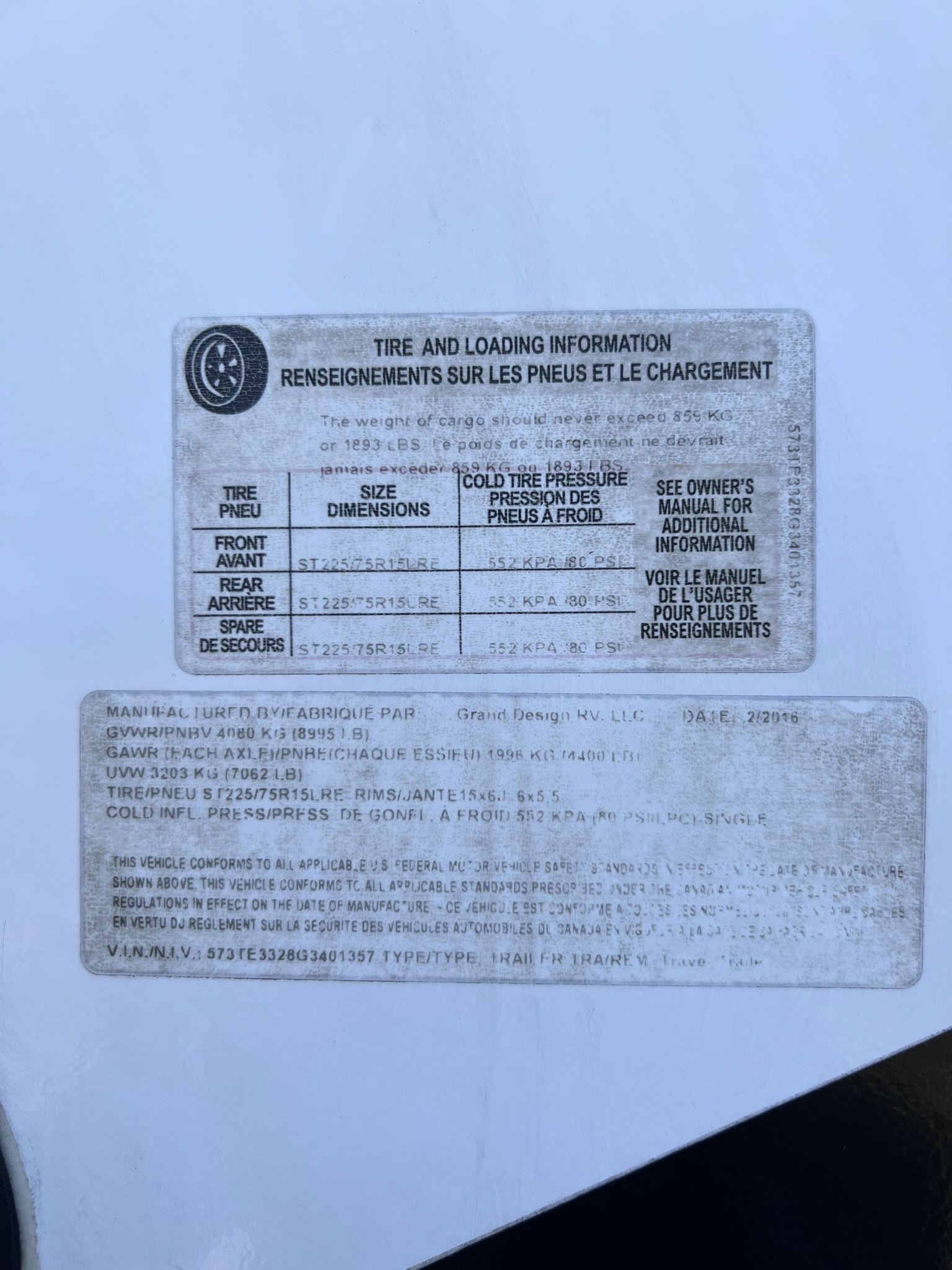RV tire pressure is not as straight forward as one may think. Unlike standard vehicle tires, one should not rely solely on a sticker. You’ve likely driven a vehicle for years with no issues. Reason being – tire pressure for a standard passenger vehicle is not that variable. That is, typical passenger vehicles aren’t designed to carry much weight, so there’s not really any need for tire pressure to vary. However, RVs are heavy and some can carry quite a large load. So what’s the big deal? I follow the sticker on my door jamb with my vehicle, can’t I do the same with my RV? In short…No.
1. Referring to the sticker on your RV
All RVs have a sticker or at least they did at one point in time. On travel trailers and fifth wheels, this sticker is typically located on the driver’s side towards the front, lists information about tire pressure and weights.
It’s important to note that this tire pressure information refers to the original tires that were installed on your RV. Depending on the age of your RV, it likely no longer has those specific tires. Also, in our experience, the sticker typically lists the max PSI. There’s a huge difference between max PSI and proper inflation for the weight you are carrying.
The best course of action is to refer to your tire manufacturer’s website. They should have a chart that references the proper PSI for the current weight of your RV. Here’s an example from Goodyear that references our trailer’s tires: https://www.goodyearrvtires.com/pdfs/rv_inflation.pdf. Based on our tires and the load we currently carry, we only require a minimum of between 45 and 50 PSI. This is way lower than what I had been filling them to, 70-75 PSI!
Note: I have recently reviewed some articles and videos suggesting to refer to the placard or sticker on your RV. Some even say somewhere between the manufactures minimum and the maximum listed on their sticker is what they go with (which seems to make a lot of sense to me). Unfortunately, there’s a lot of conflicting information out there. For the purposes of this blog, as always, the information we share is strictly based upon our experiences. Please do your own research as well, as we are not in anyway responsible for anyone’s actions.
Of course, you’ll need to know the weight of your RV. Don’t know your weight? You can use a device called Better Weigh. It plugs into your vehicle’s diagnostic port. Data is gathered by using their smartphone application. It measures other features like tongue weight and payload as well. We’ve used it, but I found the results to be varying and sometimes inaccurate. In fairness, I really need to use it a bit more to really give a full review.
Another great method is using the CAT scales at truck stops. There’s even an app for that too! We’ve used the app and the whole experience was way quicker and easier than we had imagined. You’ll need to create an account and download the app for your phone. Check out information on the CAT scales method HERE. Of course, you can still weigh your RV the old fashioned way by visiting the scale house. It’s just a little quicker to use the app.
Eventually, you’ll need to replace your RV tires. When the time comes, ensure you do your research and do NOT trust your mechanic’s advice without verification. This leads to mistake number two.
2. I should trust my RV mechanic
Of course, you can and should be able to trust your mechanic. However, getting a second opinion or checking their work will save you possible headaches down the road. With our experience, I had checked the tire pressure before our next trip (erroneously referring to the sticker on our RV). Over half way to our destination it happened…BOOM! We suffered our first blowout. This one was a doozie because it also severed critical wiring. The repair bill was somewhere in the $2k range, but luckily we had an extended warranty that took care of most of it.
After this experience, we realized our tires weren’t likely of the best quality (aside from the fact that I was likely overfilling them). We had heard references to China bombs and these tires were apparently just that…tires made in China that are of low quality. So, after our blowout I told the mechanic to replace all of them. Trusting his judgement, with no research of my own, he replaced all of them and we were back on the road. He installed truck tires, which I didn’t think too much of it, as I had read that truck tires can work for a travel trailer. Some folks even prefer them for whatever reason.
So, hardly a year later, it happened again…another blowout! This time no wiring was damaged at least, as it was on the opposite side. We were furious…how could this happen again!? I had even checked the tires, before we left (referring to the sticker of course). One must be careful when choosing their tires.
3. Any Truck Tire will work for my RV
After suffering another blowout and looking closer at our tires, I realized on important factor. The tires were designed for light duty pickups, like a Ford Ranger. Meaning that they were not much different than a standard vehicle tire, not designed to handle the weight of our RV. Furthermore, I was inflating them to 80 PSI, as you probably guessed….the number on our sticker! These tires were only supposed to be filled to about 35 PSI.
I was certainly at fault, but I could not help but be angry at the technician. Shouldn’t he know better? After reaching out to him, I was unable to get anywhere. He placed the blame on the tire company that he purchases them from. Bottom line, I should’ve done my homework.
Tire Pressure – Final Thoughts
In the end, I finally did my overdue homework and got the right tires. This time, I had them installed by the actual tire company. They’re Goodyear Endurance trailer tires and they have been awesome! My hope is that you’ll gain something from this article and do things the right way, before learning the hard way. Remember, always follow your tire manufacturer’s inflation chart, based upon your RV’s weight and certainly do not go below what they recommend. Also, ensure your using a tire that is designed to support the weight of your RV and its contents. This seems simple, but it can be easy to get confused with all of the information and misinformation out there. Safe travels out there!

